What is fan coil: principle of operation and installation rules for a fan coil
Choosing an air conditioning and heating system for your home, it makes sense to find out what a fan coil is, what functions a climate device performs, and in what situations it is advisable to use it.
In the article we provided detailed answers to the indicated questions. From the material you will learn how it works, what elements the fan coil consists of, what types of fan coil units exist and what are their features.
We indicated the rules for the placement of HVAC equipment, and also described the specifics of installing equipment in a private house and apartment.
The content of the article:
The principle of operation of the fan coil
The name of the device comes from two English words: “fan” - fan and “coil” - coil. These basic elements provide the device’s operation. A system using such devices is usually used to organize multi-zone air conditioning in large rooms.
The fan drives air through the heat exchanger. Depending on the task, hot or cold water enters the coil of the heat exchanger. The air heats up and spreads around the room.
One of the advantages of using fan coil units is the ability to not only heat and cool indoor air, but also to dilute it with fresh air masses from the street.
This option is not difficult to implement if you plan to use forced forced ventilation.
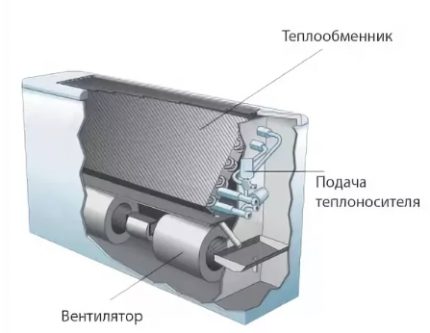
Fancoil consists of elements such as:
- heat exchanger coil;
- fan;
- filtration unit.
Only one heat exchanger can be included in the system or two at once to provide an easy transition to another operating mode.
In the latter case, one circuit is connected to chiller - a refrigeration machine that generates a stream of cold water, and the second to a heating boiler or other similar heating device. The combination of fan coil units with a heat pump is very popular.
It is worth noting that if it is decided to use chiller fan coil system, then you can install several fan coils in different rooms, and only one chiller will work for them.
The solution looks very convenient for buildings in which you need to serve a large area. But at the same time, you should correctly calculate the performance of the chiller depending on the number and characteristics of fancoils.

For fan operation, each device must be supplied with power. To clean the air masses and improve the indoor microclimate filter block.
Each fan coil is equipped with a control system, which, depending on the type of device, can be built-in, remote or remote.
In addition, for the installation of fan coil units, a set of couplings, insulation materials, etc. are required. It is mandatory that a drainage system is installed for this type of system to ensure that condensed moisture is removed.
The use of fan coils gives considerable freedom in the design of the system. You can always choose a chiller and / or boiler with the right capacity and set the desired number of fan coil units. Installation is relatively inexpensive, since conventional water pipes are used for the coolant.
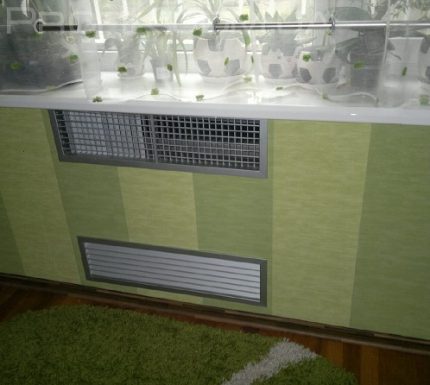
The system takes up relatively little space, if desired fan coil units and the communications leading to them can be completely hidden behind a suspended ceiling.
If we consider fan coils as an alternative to a split system, then they have an important advantage - they allow you to keep the appearance of the facade unchanged.
A device for cooling and / or heating water can be placed at a considerable distance from the fan coil units. If the installation is done correctly and the line is provided with reliable thermal insulation, the system will work efficiently.This can be convenient, especially if the building has a complex layout.
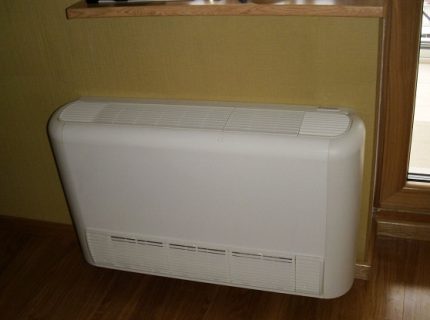
The use of ordinary plumbing rather than expensive special pipes significantly reduces the cost of the system and simplifies installation. Automation of a “chiller-fan coil” type system is performed in approximately the same way as for a split system: using a remote control.
This allows you to adjust the parameters not for the entire building, but separately for each room in which there is a fan coil.
How far can fancoils be removed from a source of heat or cold? This distance is determined by the power of the pump, which moves the liquid coolant through the pipes of the system. The higher the pump power, the greater the distance.
This significantly expands the number of options for installing both the fan coil itself and the boiler and / or chiller. The limit figure is 600 m, and this is more than a solid indicator.
The fan coil system can also be used in combination with such an economical and environmentally friendly way of generating energy as a heat pump. At the same time, it is possible to organize not only a single-circuit, but also a double-circuit heating system, i.e. provide the house with hot water.
If the system is thought out and implemented correctly, then a comfortable temperature will be established in the room within five minutes after starting.
What are fan coils?
The type of fan coil depends on the tasks that need to be solved with its help. There are two-pipe and four-pipe devices. The former can only work on heating or cooling, the latter are able to solve both problems.
Both the heater and the chiller are connected in parallel to the four-pipe fan coil units. The mode of operation of the system is selected depending on the season and needs.

However, there is an option when a two-pipe system is used for air conditioning in the summer, and then for heating in the winter. In this case, the system is switched either to the chiller or to the boiler using a special valve; the change of the system operation mode is performed manually.
This is a fairly popular version, since installing only two pipes is much simpler than conducting four structures.
Switching the operating modes when using the four-pipe system can be performed from the control panel in automatic mode.
Depending on the installation site, fan coil units are distinguished:
- floor;
- wall mounted;
- floor and ceiling;
- ceiling.
The purpose of each type of device is clear from the name. Wall-mounted fan coils most often serve as an alternative to conventional radiators of a water heating system. They are also installed along the walls under windows or in other similar places. Floor and ceiling models can be installed both above and below.
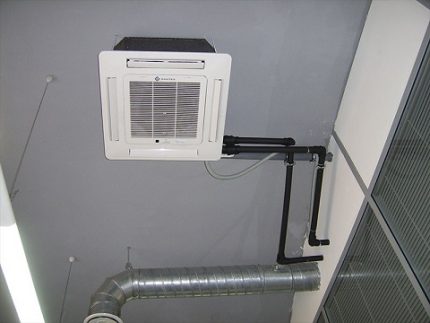
In addition, there are cassette and channel fan coil designs. Devices can also be enclosed or frameless, designed for flush mounting. This is another advantage of fan coils: they allow you to make the heating / air conditioning system almost invisible.
Some models are equipped with additional functions, for example, a fresh air intake system from the outside, the possibility of electric heating of air masses with the help of built-in heating elements. Options for organizing a management system may also be different.
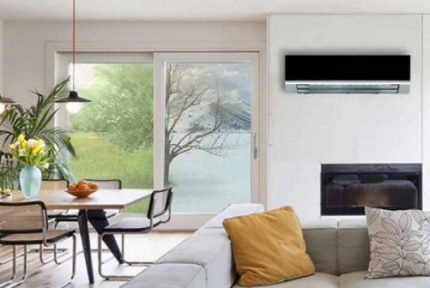
For specific brands, fan coil units are considered the best. Carrier and York. Excellent qualities are demonstrated by the company's models. Trane, and McquayThese are reliable European-made devices.
General Climate presents a wide range of fan coil units in various configurations. A company model Daikin According to the reviews of the owners, they look very stylish. Fancoils stand out among low-cost products Aerotek - A popular Chinese brand.
Features of the installation of such equipment
Installing a fan coil is not an easy task. If the owner of the house does not have much experience in installing heating and / or refrigeration equipment, it is better to contact professionals. First, the fan coil itself is installed. The installation location depends on the type of device: ceiling, floor, wall.
In any case, it is necessary to ensure the free movement of air masses from the fan coil throughout the room so that the operation of the device is effective.
After installing the fan coil, it is necessary to assemble the strapping unit, install the pipes and lay the insulation layer. You should put a number of elements such as stopcocks, temperature sensorsgauges, etc.
An excellent option for installing this type of system may be rubber coated pipes. They are compact and have good heat-insulating properties.
Mounted if necessary ducts. These structures should be soundproofed. To ensure that the water is distributed evenly throughout the system and its proper hydraulics are ensured, balancing valves are used.
The presence of these devices greatly facilitates the setup of the system, because regardless of its configuration, the same water pipes can be used everywhere.

When designing the system, it is necessary to take into account the length of the ducts, which is strictly standardized. This is especially true when installing wall-mounted fan coil units under windows. Steel ducts are equipped with a vibration muffler. Be sure to mount the condensate collection and removal system.
Moisture trays should be secured under the corresponding holes. After that, the fan and electric heaters (if any) are connected to the power supply. Then all contacts, channels and pipes are checked for leaks.
After that, the system is started and pressure tested to check the quality of installation. If there are no flaws, you can continue the finishing work.
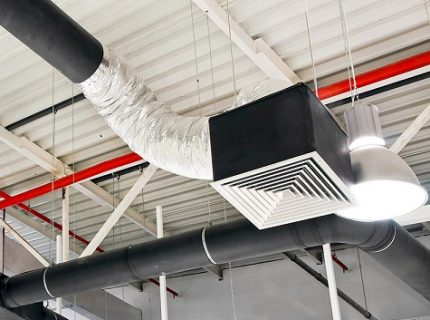
The easiest way to cope with the installation of the outdoor version of the fan coil. It does not need to install a condensate drain channel. The device has two nozzles that are connected to the corresponding device.
When mounting wall, ceiling and cassette models, the connection to the power supply is made according to a more complex scheme than for a floor fan coil.
In any case, installing a four-pipe system will be the most difficult. For the installation of any type of system, it is important to properly perform the design and a number of special calculations.
Installing a fan coil in an apartment
Devices of this type can be called universal to a certain extent. Subject to some recommendations, fan coil units can be successfully installed even in ordinary apartments.
For small areas, you can use only one fan coil, from which warm (or cold) air is distributed throughout the apartment through a duct system.
Fancoil is usually placed in the hallway or in the bathroom, pipes can be hidden under a suspended ceiling. Of course, the ceiling at the installation site of the main device will have to be lowered, which is not always convenient in apartments with small room heights.
However, in other rooms, the problem can be eliminated if you make a two- or even three-level ceiling to hide less bulky air ducts.
The location of the fan coil is due not only to the size of the device. During operation, the unit produces a significant amount of noise, which is hardly appropriate in residential premises. To service the entire apartment you will have to take a sufficiently powerful fan coil, and the more productive the device, the more noise from it.
Of course, a system with only one fan coil will be relatively inexpensive, and installation will not be too complicated. However, in this case, the advantage of the climatic multizonality characteristic of larger systems is lost.
You can control the operation of the fan coil from the remote control, but the selected mode will apply to all rooms. This is not very convenient if the windows of the rooms open on different sides and are warmed up by the sun in different ways.
An alternative is to install a small fan coil in each room or only in some rooms. In this case, it will be much easier to regulate the microclimate in individual rooms.
Noise from small devices will be less, its effect can be significantly reduced by choosing the right place for installation and using noise reduction tools.

Of course, installing such a system will cost a lot. Two or three fan coils can be installed as in the first version - in the hallway, and then part the air ducts in different rooms. In this case, the noise problem is even easier to solve. In the future, it is enough to adjust each fan coil to get a suitable temperature in individual zones.
Such systems can be used in conjunction with forced ventilation. They will not only change the temperature of the air, but also update its composition. To drain the condensate that appeared during operation, use special pumps that pump moisture into the sewer system.
Conclusions and useful video on the topic
This video describes the principles of fan coil operation and installation features of such devices:
In housing construction, fan coil units are increasingly being used effectively. It is very important to correctly design and implement the installation of a fan coil in order to ensure its smooth operation for a long time.
Is there anything to supplement, or have questions about choosing, working and installing a fan coil? Please leave comments and participate in discussions. The contact form is located below.

 Chiller-fan coil system: operating principle and arrangement of the thermoregulation system
Chiller-fan coil system: operating principle and arrangement of the thermoregulation system  What is a multi split system: principle of operation + installation and connection rules
What is a multi split system: principle of operation + installation and connection rules 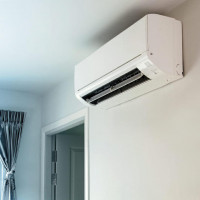 What is a split system: device and principle of operation of typical air conditioning systems
What is a split system: device and principle of operation of typical air conditioning systems 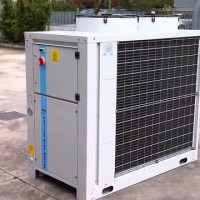 What is a chiller: device features, selection and installation rules
What is a chiller: device features, selection and installation rules 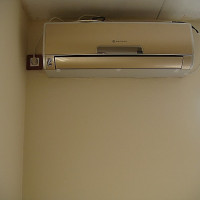 Rules for the location of the outlet for air conditioning: choosing the best place to install
Rules for the location of the outlet for air conditioning: choosing the best place to install 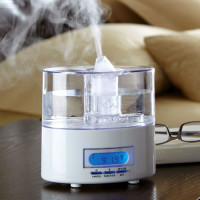 How does a humidifier work: device, principle of operation and types of devices
How does a humidifier work: device, principle of operation and types of devices  How much does it cost to connect gas to a private house: the price of organizing gas supply
How much does it cost to connect gas to a private house: the price of organizing gas supply  The best washing machines with dryer: model rating and customer tips
The best washing machines with dryer: model rating and customer tips  What is the color temperature of light and the nuances of choosing the temperature of the lamps to suit your needs
What is the color temperature of light and the nuances of choosing the temperature of the lamps to suit your needs  Replacement of a geyser in an apartment: replacement paperwork + basic norms and requirements
Replacement of a geyser in an apartment: replacement paperwork + basic norms and requirements
Absolutely agree. When choosing a fan coil, care must be taken to ensure that it consumes moderate amounts of electricity and does not generate noise. I recommended that my customers also pay attention to appearance, since aesthetics also play an important role. The environmental friendliness of the installation gives a great advantage if you use the chiller and fancoil together.
A very good solution to problems with ventilation and heating in one device at once.Probably the best option is to take a device that can both heat and cool the air in the room. This can save a lot on air conditioning systems. You do not have to install a separate unit in each room. Although there are difficulties in the installation process. Installing the system already in the living room after finishing will be problematic.